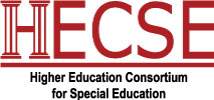History of HECSE
In 1954, only 14 universities offered programs to prepare special education leadership personnel (Smith & Salzberg, 1994). Following the passage of the Graduate Fellowship Program for the Preparation of Leadership Personnel in the Education of Mentally Retarded Children (PL 85 926) in 1958, the number of programs to prepare researchers and special education teacher educators began to expand. The passage of the Education for All Handicapped Children Act in 1975 (now known as IDEIA) mandating a free, appropriate public education for all students with disabilities, created a steady demand for special educators and related services specialists to provide specialized programs and services in the nation’s schools and an increased demand for university faculty to prepare this personnel. The current Special Education Leadership Grants program administered by the Office of Special Education Programs (OSEP) and funded through Part D of IDEA is a descendent of the original Graduate Fellowship Program (Smith, Robb, West, & Tyler, 2010).
With the growth of special education teacher preparation and doctoral programs came the need to establish an organization to foster communication among Chairpersons of Special Education teacher preparation programs. In January 1976, James Affleck from the University of Washington and Richard Schofer from the University of Missouri convened the First Invitational Conference of Chairpersons of College and University Departments of Special Education at the University of Kentucky. From that conference emerged an agreement to establish an organized effort among special education Chairpersons. The purposes of that effort were to “1) provide a vehicle for exchanging information and ideas; 2) serve as an advisory group to organizations, associations, agencies, and legislative bodies; 3) formulate standards for programs and to encourage enforcement of those standards; and 4) to influence the direction of preparation programs in special education” (Blackhurst, 1976). A follow-up meeting was planned at Ohio State University in July 1976 and on November 30, 1976, the constitution and by-laws for the Higher Education Consortium for Special Education (HECSE) were adopted.
As part of its efforts to promote appropriate and effective training and support for prospective and new faculty members in special education, HECSE established rigorous criteria for member institutions. HECSE published the first and only professional statement of doctoral program standards in this discipline by issuing a position paper entitled “Indicators of Quality in Special Education Doctoral Programs”. First published in 1984, and revised in 2009, the HECSE quality indicators for doctoral programs in special education currently are being reviewed again and are being updated to include online doctoral program standards.
HECSE has established and maintained a close working relationship with officials in the United States Department of Education’s Office of Special Education and Rehabilitative Services and with the Congressional representatives and staff members who are most directly involved in legislative initiatives related to special education and other disability issues. At the annual winter meeting conducted at the end of January and held in Washington, DC, representatives of member institutions have the opportunity to meet with key policymakers in the executive and legislative branches of government and other national leaders to learn about and share their thoughts on new developments.
In recognition of the prominence of HECSE and its member institutions in the design and delivery of doctoral programs in this discipline, in 2003, the U. S. Office of Special Education Programs appointed HECSE representatives to serve on a Blue Ribbon Committee in Washington, DC to review the application and evaluation process for the leadership competition for proposals for funding to support doctoral students available under Part D of the Individuals with Disabilities Education Act. The committee’s recommendations have served as a source of ideas for current and future changes to the leadership competition procedures.
As the 21st century opened, HECSE initiated an awards program to recognize national leaders who have been instrumental in implementing policies that have had a major impact on the field of special education and disability services. To date, these awards, listed elsewhere on this site, have recognized individuals who proposed and saw to completion policy changes that have changed the lives of individuals with special needs and their families or provided support for the professionals who serve them.
Today, HECSE continues to examine topics and issues that will challenge the field of special education in the years to come. HECSE also participates in joint activities with other professional organizations and advocacy groups to address common concerns in the areas of education and disability policy. HECSE is currently a member of the Committee for Education Funding (http://www.cef.org) and the Consortium for Citizens with Disabilities (http://www.c-c-d.org) and engages in collaborative activities with the Teacher Education Division (TED) of the Council for Exceptional Children (CEC) (http://www.tedcec.org). Member institutions and their representatives, along with partner groups, are nationally known for their extensive knowledge of personnel and leadership preparation and untiring advocacy efforts on behalf of the special education professional community.
References
- Blackhurst, E. (1976). Conference report: First invitational conference of chairpersons of college and university departments of special education. Unpublished proceedings.
- Smith, D. D., Robb, S. M., West, J., & Tyler, N. C. (2010). The changing education landscape: How special education leadership preparation can make a difference for teachers and their students with disabilities. Teacher Education and Special Education, 33(1), 25-43.
- Smith, D., & Salzberg, C. (1994). The shortage of special education faculty: Toward a better understanding. Teacher Education and Special Education, 17, 52-61.
*Special thanks to Deborah Deutsch Smith and Ed Blackhurst who provided much of the background information needed for this brief history.

